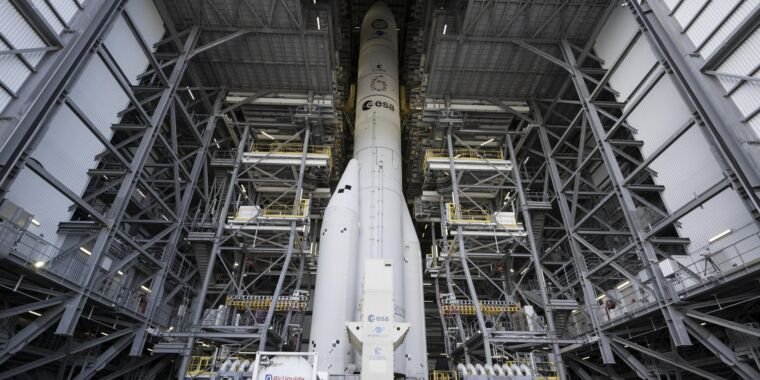Europe’s Ariane 6 rocket is finally ready to fly, four years late but vital as ever for European governments backing the more than $4 billion project.
Set for liftoff from French Guiana, the new rocket will be Europe’s flagship launcher for the next decade, providing rides to space for European science probes, navigation satellites, and military payloads. Ariane 6 also has a toehold in the commercial market, with a contract for 18 launches to deliver satellites to orbit for Amazon’s Project Kuiper broadband network.
The first Ariane 6 rocket has a four-hour launch window opening at 2 pm EDT (18:00 UTC) Tuesday to depart the European-run Guiana Space Center in South America.
“Ariane 6 is Europe’s workhorse for guaranteed access to space,” said Lucia Linares, head of space transportation strategy and institutional launches at ESA. “It is a true European public and industrial undertaking with the involvement of 13 European Space Agency member states and more than 600 companies across Europe.”
The launch comes a decade after officials settled on the basic design of the expendable Ariane 6 launcher, and nine years after the European Space Agency awarded a multibillion-dollar contract to a consortium of European companies to develop the continent’s next big rocket.
The debut of Ariane 6 also comes almost exactly a year after the final flight of the Ariane 5 rocket, which notched 117 flights from 1996 through 2023. The Ariane 5, like the Ariane 4 and other Ariane rockets before it, was a market leader for launching large commercial communications satellites until SpaceX’s Falcon 9 rocket took the top position in recent years.
ESA is overseeing the Ariane 6 demonstration flight before handing over commercial operations to Arianespace later this year. You can watch ESA’s live broadcast of the inaugural Ariane 6 launch below.
High stakes
It hasn’t been an easy road for Ariane 6 to reach this point. Inaugural flights of new rockets are risky, so ESA did not put a pricey payload on the first Ariane 6.
“About half of the inaugural flights do not go as planned,” said Toni Tolker-Nielsen, ESA’s director of space transportation, in a prelaunch press briefing. “I think we can do better with Ariane 6, but the 9th of July will confirm that for me.”
Asked about his mood and stress levels going into the maiden flight of Ariane 6, he replied he was about 96 percent confident.
“If it goes wrong, we’re going to do some investigations to find out what happened,” Tolker-Nielsen said. “If it went badly, we’re going to correct it and we are going to do a second demonstration flight.”
The first flight of the Ariane 5 rocket didn’t make it far from the launch pad on June 4, 1996. It lost control, broke apart, and exploded about 30 seconds after liftoff. An investigation found that the accident was caused by software code from the Ariane 4 rocket that engineers entered into the Ariane 5’s guidance system. The explosion destroyed four ESA scientific satellites, resulting in a total loss of $370 million in 1996 dollars.
Lesson learned for Ariane 6.
“Everyone is aware of the issues linked to an inaugural flight, so everyone is aware of the risk of failure,” said Franck Huiban, head of civil programs at ArianeGroup, Ariane 6’s prime contractor.
If all goes according to plan, the rocket will climb into low-Earth orbit, release nine small satellites, and exercise its upper stage with a series of burns to simulate maneuvers required on future operational Ariane 6 missions. Finally, the upper stage will steer toward a destructive plunge into the atmosphere over the Pacific Ocean and deploy two commercial reentry capsules to test heat shield materials.
Engineers from ESA and ArianeGroup will oversee the launch countdown Tuesday from two main control centers at the Guiana Space Center. Early Tuesday, they will start loading thousands of gallons of super-cold liquid hydrogen and liquid oxygen into the two-stage Ariane 6 rocket.
After a series of final checks, managers will give their “go” for launch and give the command for the rocket to light its Vulcain 2.1 main engine around seven seconds prior to liftoff. Then, two powerful solid rocket boosters will ignite to propel the 183-foot-tall (56-meter) rocket off the launch pad.
This configuration of the Ariane 6, called the Ariane 62, will generate nearly 1.9 million pounds (8,400 kilonewtons) of thrust at full power. A larger version, the Ariane 64 with four strap-on boosters, is tailored for heavier payloads and higher orbits. Ariane 6’s boosters are derived from the first stage motor used on Europe’s smaller Vega C rocket.
Heading northeast over the Atlantic Ocean, Ariane 6 will jettison its two spent solid boosters nearly two-and-a-half minutes after launch, then release its clamshell-like payload shroud around three-and-a-half minutes into the flight. The hydrogen-fueled Vulcain 2.1 main engine will continue firing until seven-and-a-half minutes.
The Ariane 6 main engine is similar to the engine used on the Ariane 5 rocket, but with a redesigned, easier-to-manufacture nozzle and a 3D-printed gas generator. The Vulcain 2.1 also has a simplified ignition system.
Source link
